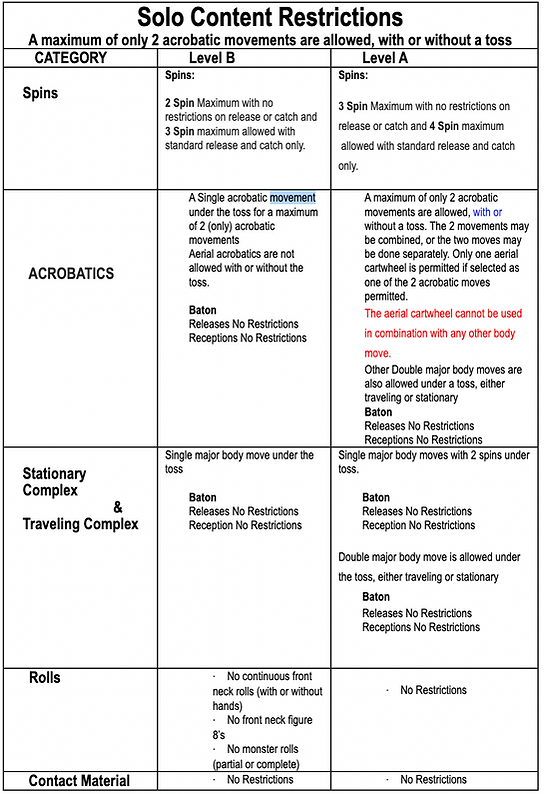
IBTF Resources & Rule Clarifications
SCROLL DOWN BELOW to find answers to the questions you asked!
These rule clarifications come directly from the Technical Sport Commission to help you to better understand discipline requirements and/or restrictions with examples.
Seeking clarification? Email ASK@ibtf-batontwirling.org
Have
Solo LEVEL A & B Major Body Move Restrictions
Clarification: One major body move is allowed under a toss in Level B. Two major body moves are allowed under a toss in Level A.
It is NOT allowable to add minor body moves after the toss or before the catch at either level.

Artistic Twirl Lane Dimensions - Turin 2025
NEW UPDATE
Due to the size of the competition, an amendment has been made to the lane size for Artistic Twirl in Turin 2025.
Each lane will consist of a performance area of 10m x 10m / 32.5ft x 32.5ft, with 6 lanes competing simultaneously. (See diagram)
While there are no official penalties for stepping into 'safe areas', coaches and athletes are highly encouraged to adjust routines to fit the newly allocated lane sizes.
For any further questions, please contact your federations Technical representatives.

FAQ
X-Strut LEVEL A Content Restrictions
'Spins' = pure spins with the foot to the ankle/ lower than the knee - these are MINOR body moves.
Other spins / turns that require the working foot to be above the knee and/or in use outward of the body - e.g. spin with kick; spin whilst holding leg; turning fan kick; attitude turns; pirouettes; fouettes; lunging spin/ wolf turn etc are MAJOR body moves.
In the A Level X-STRUT - only TWO MAJOR body moves may be executed in a row on one foot.
Remember, a minor move (such as a pure spin or other) can NOT be added before or after the Double Major moves.
What is the difference between a double and a triple element?
Combining major and minor movements... what does that look like?
Double major body moves executed on one foot ARE permitted
Example #1:
Spin + Illusion
Example #2
Ron De Jambe + Illusion (A)
Example #3
Ron De Jambe + Illusion (B)
Example #4
Grand Battement Turning + Layback
Example #5
2 Spins in Attitude
Triple major body moves executed on one foot or simultaneously
ARE NOT permitted stationary or traveling in Level A
Example #1:
Illusion + Jump + Illusion
Example #2
Illusion + Cabriole + Illusion
Example #3
Grand Battement + Grand Battement +
Ron De Jambe in Layback
Example #4:
Grand Battment + Attitude + Cabriole
Combining or splitting double major elements with minor body moves is NOT permitted
Example #1:
Illusion + Passé + Illusion
(Major + Minor + Major)
Example #2
Grand Battement + Grand Battement + Passé
(Double Major + Minor)
Example #3
Grand Battement + Grand Battement +
Passé + Layback
(Double Major + Minor + Major)
Elements where the balance leg is changed are not restricted
Example #1:
Grand Battment Turning + Illusion
Example #2
3 Grand Jeté Changing Legs
Two Baton LEVEL B & A: Releases and Catches
What is a Double Aerial Release?
Aerial refers to HIGH Tosses.
Therefore, 'Double Aerial Release' refers to
BOTH batons released simultaneously (from one or both hands) BOTH in the toss/aerial mode.
Only TWO of these are permitted in LEVEL B Two Baton.
Any number may be performed in LEVEL A.
Example #1:
Example #2
Example #3
Examples #4 and #5 are NOT Double Aerial Releases as one baton remains in the contact mode. These are Double Releases are not restricted.
Example #5
Example #6
Are blind, head and/or back catches which require a half turn to complete permitted in Two Baton?
LEVEL B content restrictions state ONE spin maximum with no restrictions on catches.
Athletes are not permitted to complete two or more spins under a single baton.
This means 1.5 spins IS permitted in the case of catches that require a half turn to complete.
This would mean LEVEL A Two Baton allows for 2.5 spins under a single baton
in the case of catches that require a half turn to complete.
Example #1:
Example #4:
Example #2
Example #5
Example #3
Example #6
Three Baton LEVEL A: Triple Tosses
What is the difference?
What is allowed in A?
Simultaneous Triple Tosses are NOT permitted in LEVEL A.
This is when ALL THREE batons are released at the SAME TIME.
Sequential Triple Toss/es ARE ALLOWED, but only TWO times in a routine.
Simultaneous Triple Toss
Sequential Triple Toss examples
With thanks to Sabrina Prade, Ginnette Groome and our demonstrators
.png)